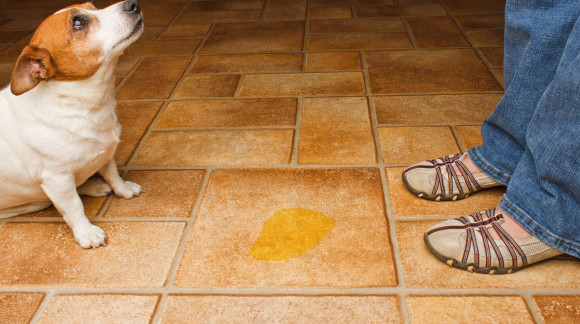Housebreaking You Pet: Tips for Successful Training

How to Housebreak Your Pet
When you get a new puppy, housebreaking is usually a top priority. However, dogs generally do not develop the muscle control needed to regulate when they go to the bathroom until they reach about 12 weeks of age. Until that time, you need to take your dog out regularly and contain your dog in limited areas to prevent your puppy from ruining a favorite blanket.
When you are not with your dog, crate training is a good idea because dogs do not like to go to the bathroom in a crate that they view as their “den.”
Seven Steps to Housebreaking Your Dog
When your puppy has reached the age when he or she can “hold it,” follow the steps below to establish healthy bathroom habits.
1. Learn the signs of elimination. If your dog begins to walk in circles or sniffs the ground, whines or barks, he probably needs to use the bathroom. Pay attention to your dog’s body language and sounds. When you notice these signs, take your dog outside quickly.
You should also be aware that puppies instinctively desire to use the bathroom after they eat, drink, sleep, play or rest. Take your dog outside within five to 30 minutes after these activities.
2. Feed your dog a measured amount of food at the same time each day. Feeding your dog at the same time each day will help you to have more control over when your dog needs to go to the bathroom. You should put the full bowl down and then pick it up either when the food has been finished, when the dog walks away or after about fifteen minutes have passed.
3. Take your dog outside on a leash to the same spot each time you want your dog to use the bathroom. Do not just let your dog out into the yard and hope that he goes to the bathroom. When your dog has eaten, drank, played or woken from sleep, put him on a leash and take him to the same place each time. This way, your dog will become accustomed to eliminating in that area. You must take a young dog outside frequently to establish a habit.
4. Use verbal cues to prompt your dog to eliminate. For example, you can say “do your business,” each time you want your dog to go to the bathroom. Verbal cues will eventually train your dog to eliminate each time he or she hears those words. Verbal cues can be invaluable in times when you need your dog to go to the bathroom quickly.
5. Praise and reward your dog every time he or she goes to the bathroom outside. Quietly praise your dog as soon as he begins to eliminate in the desired spot. As soon as your dog is finished, loudly praise him and reward the action with a treat right away. Do not wait to give the food reward until he has gone into the house or he will not associate the reward with using the bathroom because too much time has passed.
6. If your dog does not eliminate when expected, try again. Supervise your dog after taking him inside and placing him in his confinement area. Try to take your dog out again every 15 minutes until the dog uses the bathroom.
7. Be careful with the signals you send. Do not punish your dog for using the bathroom in the house, especially if you missed them in the act. Your dog will not understand that the problem is going bathroom in the house and may think he will get in trouble every time he goes to the bathroom. This fear can prompt the dog to hide whenever he needs to use the bathroom. If you catch your dog in the act, immediately take him outside. Otherwise, if your dog has an accident in the house, just accept it as part of the process and keep trying the training techniques above until your dog succeeds.
With training, your dog will become a welcomed part of your family and will provide you with the joy of companionship, love, and devotion.
Additional Resources
- Understanding verbal clues when training your puppy, by Dogster.com
- Dog Whisperer Training Methods, by Dog Training Central
- Housebreaking Your Pet 101, by Animal Planet, Pets 101
- Housebreaking your new Puppy, by Dog Training Secrets
- How do you Know When Your Dog Has to go to the Bathroom, by Babycenter
- Housebreaking a Puppy or Dog, by Things4YourDog.com
- Housetraining, by Dr. Foster and Smith at PetEducation.com
- How to Housebreak a Puppy Without a Crate, by Francine Richards
Videos
- How to Housebreak your Pet, by Puppyhousebreaking101.com
- Using Hand Signals to train your Pet, by the Dog Whisperer
- How to housebreak your pet, by howcast, YouTube
- How to Housebreak an Older Dog, by Jay Smith
Education
- Dog Training Classes and Private Lessons, at Petco by Petco.com
- Online Dog Training Class 101, by Universal Class
Books
- Crate Training, by Teoti Anderson, available on Kindle
- How to Housebreak Your Dog in 7 Days, by Shirlee Kalstone, available on Kindle
- Clicker Training for Dogs, a Beginners Guide, by Stuart Roberts, available on Kindle
- Housetraining Success Formula, by Carol Miller, available on Kindle
